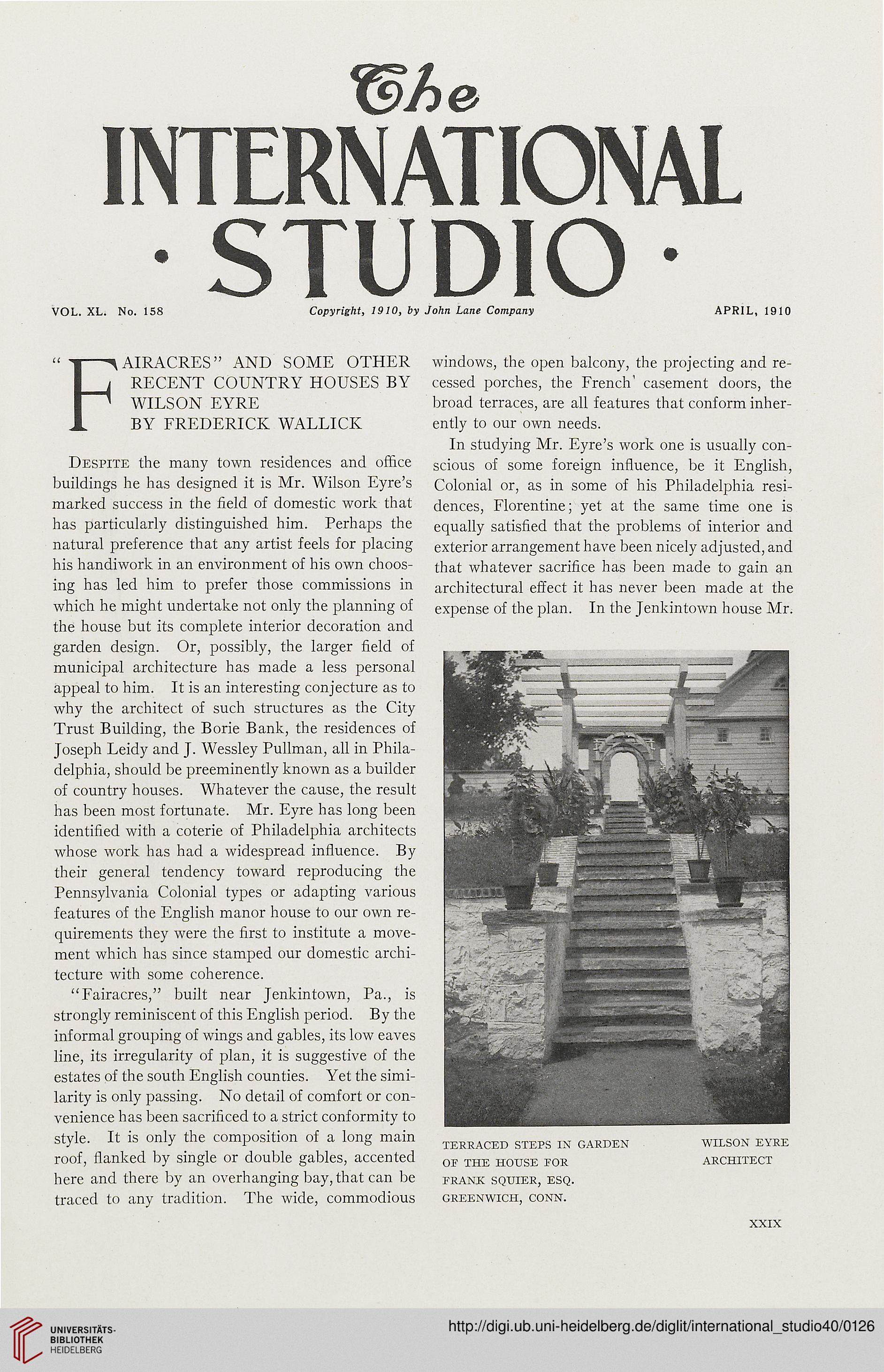INTERNATIONAL
• STUDIO •
VOL. XL. No. 1S8 Copyright, 1910, by John Lane Company APRIL, 1910
F^AIRACRES" AND SOME OTHER
i RECENT COUNTRY HOUSES BY
' WILSON EYRE
BY FREDERICK WALLICK
Despite the many town residences and office
buildings he has designed it is Mr. Wilson Eyre's
marked success in the field of domestic work that
has particularly distinguished him. Perhaps the
natural preference that any artist feels for placing
his handiwork in an environment of his own choos-
ing has led him to prefer those commissions in
which he might undertake not only the planning of
the house but its complete interior decoration and
garden design. Or, possibly, the larger field of
municipal architecture has made a less personal
appeal to him. It is an interesting conjecture as to
why the architect of such structures as the City
Trust Building, the Borie Bank, the residences of
Joseph Leidy and J. Wessley Pullman, all in Phila-
delphia, should be preeminently known as a builder
of country houses. Whatever the cause, the result
has been most fortunate. Mr. Eyre has long been
identified with a coterie of Philadelphia architects
whose work has had a widespread influence. By
their general tendency toward reproducing the
Pennsylvania Colonial types or adapting various
features of the English manor house to our own re-
quirements they were the first to institute a move-
ment which has since stamped our domestic archi-
tecture with some coherence.
"Fairacres," built near Jenkintown, Pa., is
strongly reminiscent of this English period. By the
informal grouping of wings and gables, its low eaves
line, its irregularity of plan, it is suggestive of the
estates of the south English counties. Yet the simi-
larity is only passing. No detail of comfort or con-
venience has been sacrificed to a strict conformity to
style. It is only the composition of a long main
roof, flanked by single or double gables, accented
here and there by an overhanging bay, that can be
traced to any tradition. The wide, commodious
windows, the open balcony, the projecting and re-
cessed porches, the French' casement doors, the
broad terraces, are all features that conform inher-
ently to our own needs.
In studying Mr. Eyre's work one is usually con-
scious of some foreign influence, be it English,
Colonial or, as in some of his Philadelphia resi-
dences, Florentine; yet at the same time one is
equally satisfied that the problems of interior and
exterior arrangement have been nicely adjusted, and
that whatever sacrifice has been made to gain an
architectural effect it has never been made at the
expense of the plan. In the Jenkintown house Mr.
terraced steps in garden wilson eyre
of the house for architect
frank squier, esq.
greenwich, conn.
xxix
• STUDIO •
VOL. XL. No. 1S8 Copyright, 1910, by John Lane Company APRIL, 1910
F^AIRACRES" AND SOME OTHER
i RECENT COUNTRY HOUSES BY
' WILSON EYRE
BY FREDERICK WALLICK
Despite the many town residences and office
buildings he has designed it is Mr. Wilson Eyre's
marked success in the field of domestic work that
has particularly distinguished him. Perhaps the
natural preference that any artist feels for placing
his handiwork in an environment of his own choos-
ing has led him to prefer those commissions in
which he might undertake not only the planning of
the house but its complete interior decoration and
garden design. Or, possibly, the larger field of
municipal architecture has made a less personal
appeal to him. It is an interesting conjecture as to
why the architect of such structures as the City
Trust Building, the Borie Bank, the residences of
Joseph Leidy and J. Wessley Pullman, all in Phila-
delphia, should be preeminently known as a builder
of country houses. Whatever the cause, the result
has been most fortunate. Mr. Eyre has long been
identified with a coterie of Philadelphia architects
whose work has had a widespread influence. By
their general tendency toward reproducing the
Pennsylvania Colonial types or adapting various
features of the English manor house to our own re-
quirements they were the first to institute a move-
ment which has since stamped our domestic archi-
tecture with some coherence.
"Fairacres," built near Jenkintown, Pa., is
strongly reminiscent of this English period. By the
informal grouping of wings and gables, its low eaves
line, its irregularity of plan, it is suggestive of the
estates of the south English counties. Yet the simi-
larity is only passing. No detail of comfort or con-
venience has been sacrificed to a strict conformity to
style. It is only the composition of a long main
roof, flanked by single or double gables, accented
here and there by an overhanging bay, that can be
traced to any tradition. The wide, commodious
windows, the open balcony, the projecting and re-
cessed porches, the French' casement doors, the
broad terraces, are all features that conform inher-
ently to our own needs.
In studying Mr. Eyre's work one is usually con-
scious of some foreign influence, be it English,
Colonial or, as in some of his Philadelphia resi-
dences, Florentine; yet at the same time one is
equally satisfied that the problems of interior and
exterior arrangement have been nicely adjusted, and
that whatever sacrifice has been made to gain an
architectural effect it has never been made at the
expense of the plan. In the Jenkintown house Mr.
terraced steps in garden wilson eyre
of the house for architect
frank squier, esq.
greenwich, conn.
xxix




